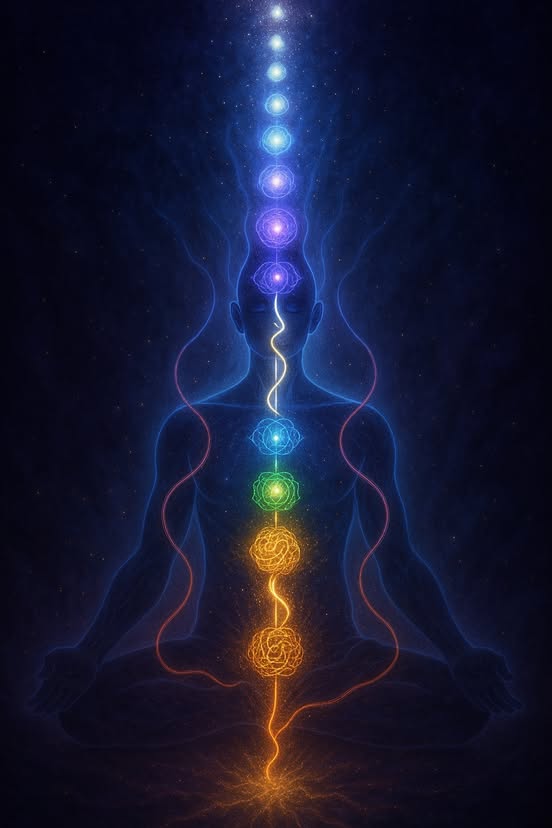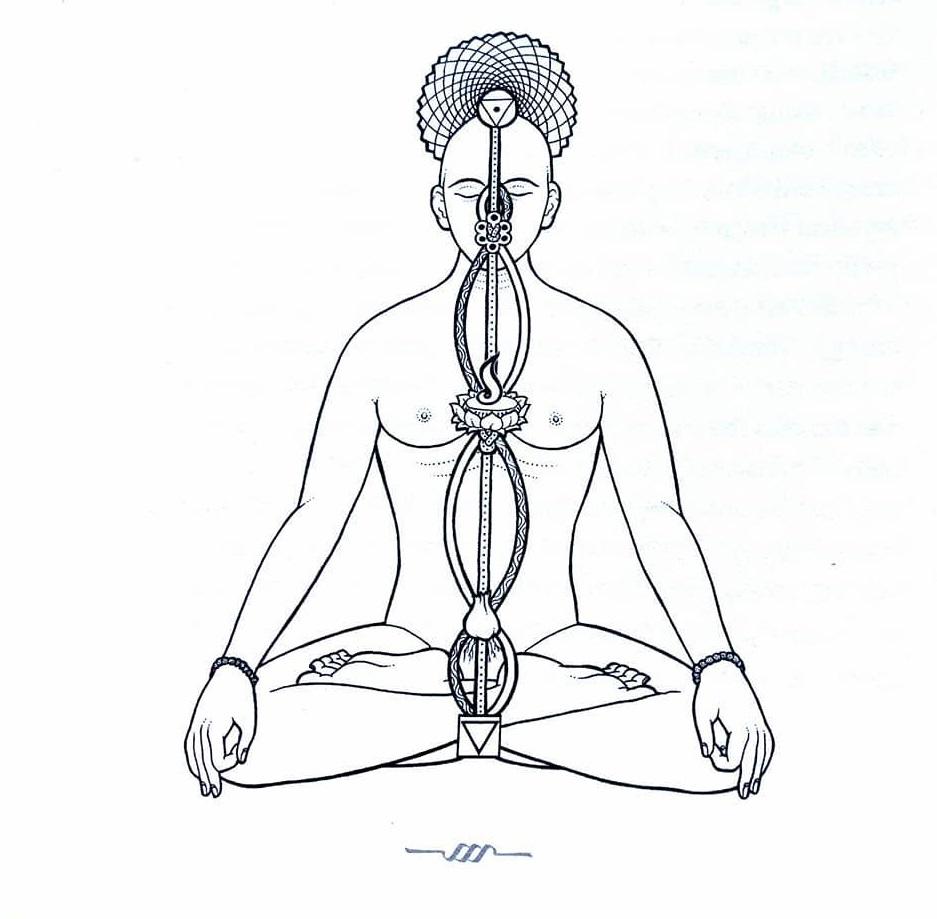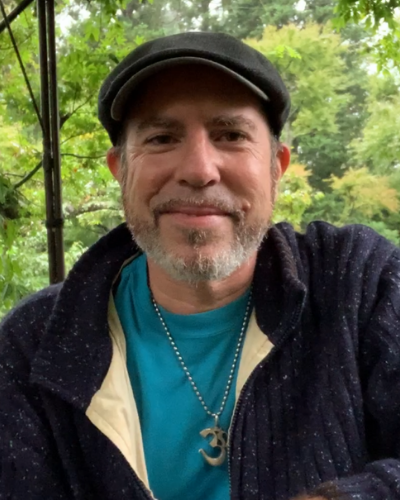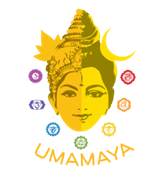In the Tantrik chakra system, it is said there are 3 major knots of consciousness – the granthis. These energetic knots, nexuses of confabulated psychology, represent a kind of tension or entanglement within our awareness—patterns of fear, attachment, ego, or unresolved emotion—that bind our sense of self. It’s like a psychic tangle that prevents clear perception and spiritual flow. These granthi are found at major chakra locations or intersection points in the energy system, along the central channel where the vital forces converge. Each granthi is located near one of these powerful hubs. They are traditionally seen as points where the Kundalini energy can get blocked or encounter resistance as it rises.
A granthi serves a function; it’s not bad. Sometimes it serves as a vital anchor of your identity. Sometimes we lose flexibility and become bound to an aspect of our identities. Here is where cord-cutting rituals are intended to be applied—not externally, as in the case of ‘cutting’ karmic ties or generational patterns, but internally. We loosen a thread to free ourselves from a particular attachment that is past its due date and no longer serves us. They are part of human development—part of our psychic make-up. But in spiritual awakening, Kundalini must pierce these knots for higher consciousness to unfold.
The three granthis are:
Brahma Granthi (at the base of the spine, near the root chakra)
The Brahma Granthi binds you to physical survival and material attachment.
Vishnu Granthi (at the heart chakra)
The Vishnu Granthi binds you to emotions, relationships, and personal identity.
Rudra Granthi (at the throat chakra)
The Rudra Granthi binds you to ego, willpower, and mental constructs.
When Kundalini energy (a.k.a. awakening awareness) moves through these knots and encounters a blockage, the discomfort or challenges can vary depending on which granthi is being affected. For example:

Brahma Granthi (Root Chakra / Muladhara)
Physical discomfort: This knot is associated with primal fears, survival instincts, and attachment to the physical world. If energy gets blocked here, you may experience intense sensations in the pelvic region, lower back, or legs—often described as a feeling of heaviness, tightness, or pressure. There may also be a sense of restlessness or difficulty grounding.
Emotional discomfort: Deep-seated fears related to safety, security, and belonging might surface. You may feel a sense of insecurity or fear about survival, finances, or basic needs.
Mental discomfort: Feelings of being stuck or trapped in your life situation can arise, as well as an inability to move forward or manifest your goals.
Vishnu Granthi (Heart Chakra / Anahata)
Physical discomfort: The blockage in the heart chakra can lead to sensations of tightness or constriction in the chest, lungs, or upper back. There may be a sensation of being choked, difficulty breathing deeply, or even mild heart palpitations.
Emotional discomfort: Blockages in this area can bring up unprocessed grief, emotional pain, or unresolved trauma, especially related to love, relationships, or self-worth. There might be an overwhelming sense of loneliness, isolation, or emotional numbness.
Mental discomfort: If the heart center is blocked, you might struggle with feelings of emotional fragmentation, a lack of empathy, or difficulty expressing affection or love toward yourself or others. There may be an inability to forgive or let go of past hurts.
Rudra Granthi (Throat Chakra / Vishuddha)
Physical discomfort: This granthi governs expression and communication. When blocked, you may experience tightness, soreness, or discomfort in the throat, jaw, neck, or even the mouth. It can feel like there’s a lump in the throat or difficulty swallowing. There may also be tension headaches or jaw clenching.
Emotional discomfort: Blockages here are often associated with fear of expressing oneself or feeling misunderstood. You might experience frustration, irritability, or a sense of being unheard or silenced. Unspoken truths or repressed emotions might cause anxiety or discomfort.
Mental discomfort: The inability to communicate clearly or authentically can create internal conflict. This blockage might bring about feelings of self-doubt or confusion around one’s identity and how to express one’s true thoughts or feelings.

General Symptoms of Blocked Kundalini Energy
Physical Sensations: People might feel a variety of physical sensations as energy moves through blockages, such as tingling, numbness, heat, or cold. Some might even experience pain or pressure as the energy tries to clear these blockages.
Emotional Upheaval: Blockages can cause intense emotional swings or cathartic releases. Deeply buried emotions may surface, causing feelings of fear, anger, sadness, or confusion.
Mental Confusion: People might experience mental fog, difficulty concentrating, or a sense of being overwhelmed as the mind attempts to process the energy moving through blocked channels.
Spiritual Discomfort: Since these knots are deeply tied to our spiritual and psychological identity, there can be moments of profound existential questioning, crisis, or spiritual disorientation.
How to Alleviate Discomfort During Kundalini Rising Through the Granthis
When Kundalini energy encounters the granthis—the subtle energetic knots within the central channel—it may stir up intense physical, emotional, or psychological discomfort. These knots correspond to deep-seated attachments and patterns of consciousness, and their unraveling can be both liberating and overwhelming. To support this process, a variety of complementary practices may help ease the symptoms and allow for smoother energetic integration:
Grounding Practices
Activities that reconnect you to the Earth are essential when Kundalini energy becomes intense, especially around the Brahma granthi at the root. Gentle yoga, walking barefoot in nature, gardening, or working with grounding crystals such as hematite or black tourmaline can help stabilize excess energy and bring a sense of calm embodiment. (See Guide 1)
Breathwork
Conscious breathing (pranayama) serves as both a regulator and a bridge—helping to clear stagnation and restore flow. Practices like Anahata pranayama, which center on the heart, can help dissolve emotional blocks and support the loosening of the Vishnu granthi. Always proceed with guidance from an experienced teacher, as improper technique may exacerbate symptoms rather than relieve them.
Mantras and Sound Therapy
Sound, especially in the form of sacred mantras, is one of the most powerful tools for working through the knots. Chanting with awareness sends vibration into the subtle body and can act as a “sound needle”—piercing and untangling the energetic blockages gently from within. Classical techniques that raise the mantra through the central channel (Sushumna nadi) help to awaken and harmonize the flow of Kundalini as it ascends.
Energy Healing
Energy-based modalities like Reiki, acupuncture, polarity therapy, or intuitive energy healing can provide external support when self-regulation is difficult. Skilled practitioners may help identify blockages or imbalances and assist in the gentle unraveling of stuck energy. Learning to work with your own energetic field can also be a deeply empowering step on the path.
Wisdom Practices
In times of intense awakening, the mind seeks stability and understanding. Immersing oneself in classical wisdom traditions—whether yogic, Vedantic, Taoist, Buddhist, Tantrik, or mystical strands of other cultures—offers a framework for interpreting the internal changes taking place. The granthis are not only energetic knots but reflections of inner limitations: fears, attachments, and identity structures. Through sincere study of authentic, integrative teachings, one gradually cultivates the discernment and insight (viveka) necessary to navigate the spiritual terrain. Knowledge rooted in integrity, compassion, and lived experience helps reorient the being—transforming confusion into clarity, and discomfort into revelation.
If you’re experiencing discomfort as energy moves through these areas, it’s important to proceed with patience and self-compassion, as clearing blockages often takes time. And reach out for guidance specific to your personal condition from a practitioner who may be able to gently support you on your way.

…is a Saiva Tantrika, Gyana Yogi and founder of Uma Maheshwara Yoga & Ayurveda. David has an MA in Semiotics, lives in Japan with his family and works as a coach in L & D, devoting his time to developing science-based tools and programs that help people reach the fullest potential of the human condition.
Discover more from REAL YOGA
Subscribe to get the latest posts sent to your email.

